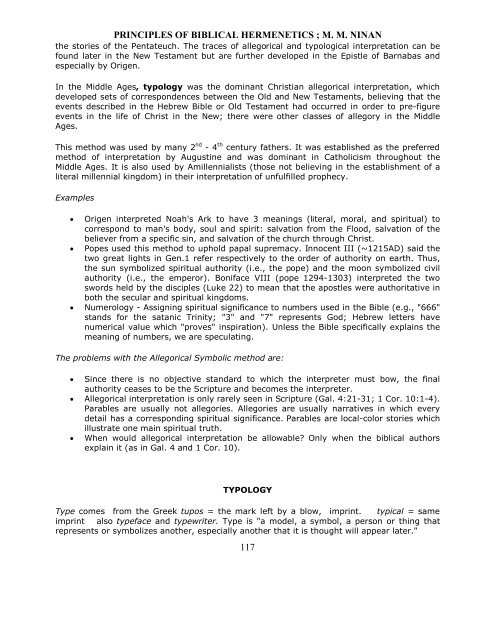Biblical Hermeneutics
Create successful ePaper yourself
Turn your PDF publications into a flip-book with our unique Google optimized e-Paper software.
PRINCIPLES OF BIBLICAL HERMENETICS ; M. M. NINAN<br />
the stories of the Pentateuch. The traces of allegorical and typological interpretation can be<br />
found later in the New Testament but are further developed in the Epistle of Barnabas and<br />
especially by Origen.<br />
In the Middle Ages, typology was the dominant Christian allegorical interpretation, which<br />
developed sets of correspondences between the Old and New Testaments, believing that the<br />
events described in the Hebrew Bible or Old Testament had occurred in order to pre-figure<br />
events in the life of Christ in the New; there were other classes of allegory in the Middle<br />
Ages.<br />
This method was used by many 2 nd - 4 th century fathers. It was established as the preferred<br />
method of interpretation by Augustine and was dominant in Catholicism throughout the<br />
Middle Ages. It is also used by Amillennialists (those not believing in the establishment of a<br />
literal millennial kingdom) in their interpretation of unfulfilled prophecy.<br />
Examples<br />
• Origen interpreted Noah's Ark to have 3 meanings (literal, moral, and spiritual) to<br />
correspond to man's body, soul and spirit: salvation from the Flood, salvation of the<br />
believer from a specific sin, and salvation of the church through Christ.<br />
• Popes used this method to uphold papal supremacy. Innocent III (~1215AD) said the<br />
two great lights in Gen.1 refer respectively to the order of authority on earth. Thus,<br />
the sun symbolized spiritual authority (i.e., the pope) and the moon symbolized civil<br />
authority (i.e., the emperor). Boniface VIII (pope 1294-1303) interpreted the two<br />
swords held by the disciples (Luke 22) to mean that the apostles were authoritative in<br />
both the secular and spiritual kingdoms.<br />
• Numerology - Assigning spiritual significance to numbers used in the Bible (e.g., "666"<br />
stands for the satanic Trinity; "3" and "7" represents God; Hebrew letters have<br />
numerical value which "proves" inspiration). Unless the Bible specifically explains the<br />
meaning of numbers, we are speculating.<br />
The problems with the Allegorical Symbolic method are:<br />
• Since there is no objective standard to which the interpreter must bow, the final<br />
authority ceases to be the Scripture and becomes the interpreter.<br />
• Allegorical interpretation is only rarely seen in Scripture (Gal. 4:21-31; 1 Cor. 10:1-4).<br />
Parables are usually not allegories. Allegories are usually narratives in which every<br />
detail has a corresponding spiritual significance. Parables are local-color stories which<br />
illustrate one main spiritual truth.<br />
• When would allegorical interpretation be allowable? Only when the biblical authors<br />
explain it (as in Gal. 4 and 1 Cor. 10).<br />
TYPOLOGY<br />
Type comes from the Greek tupos = the mark left by a blow, imprint. typical = same<br />
imprint also typeface and typewriter. Type is "a model, a symbol, a person or thing that<br />
represents or symbolizes another, especially another that it is thought will appear later."<br />
117


















